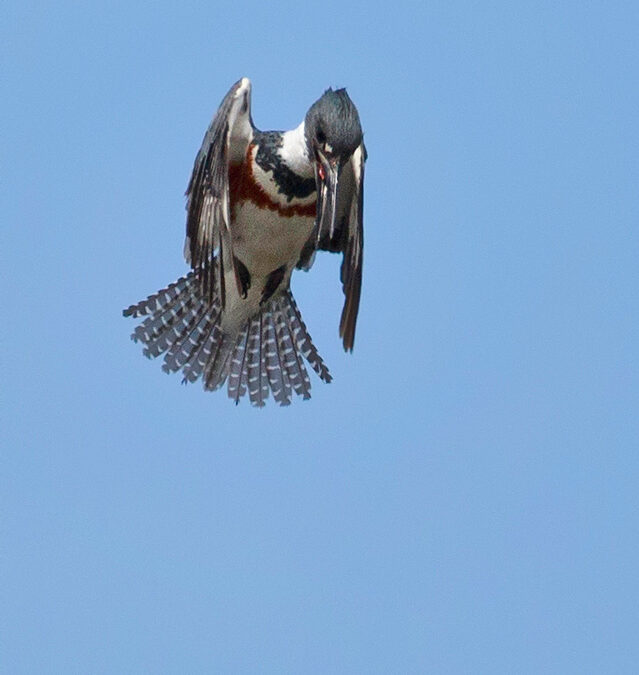
by Scott Martin Photography | Apr 23, 2013 | Birds, Blog, Shore Birds & Waterfowl
The Belted Kingfisher is one of approximately one hundred species of Kingfishers world-wide however it the only Kingfisher found commonly throughout the entire North American continent. It is an easily recognizable bird owing to its relatively large head and bill along with a shaggy looking crest. One of few birds that nests underground where it lives in a burrow dug out of the side of a river bank. Interestingly, it always burrows in an uphill direction such that in the event of flooding an air pocket is trapped at the top of the burrow allowing it to survive until the flood waters recede. Kingfisher tunnels have been recorded up to eight feet in length. Its diet consists of many things including crayfish, amphibians, small mammals, birds and even berries however it is primarily a fish specialist. The Belted Kingfisher perches above streams or hovers in flight above the water looking for fish to dive for.
For bird photographers, the Belted Kingfisher often appears on the top of what is euphemistically known as the nemesis list, or list of birds that has generated the most difficulty, frustration and angst to photograph. Although Belted Kingfishers are very common along rivers and streams in North America, they tend to be very skittish and don’t allow people close access, thus making them difficult to photograph. My good friend and fellow bird photographer Arni Stinnissen and I have enjoyed a friendly rivalry over the past few years to capture some quality images of Kingfishers, and most certainly Arni’s results have been far superior to mine as you can see in his Kingfisher Gallery. Last month, while vacationing in Florida, Deb & I had the opportunity to watch a Belted Kingfisher fish for about thirty seconds approximately one hundred feet from where we were standing on the shore of Lake Kissimmee. Fortunately I was able to get a few shots of the Belted Kingfisher diving. Although the distance from the bird precluded the quality of images one would like, they do capture the diving behaviour of the Kingfisher which is something rather unusual and I trust you will enjoy seeing.
The Kingfisher was hunting along the shoreline of the lake and as there were no perches in the area, she would hover about thirty feet above the water looking for fish.
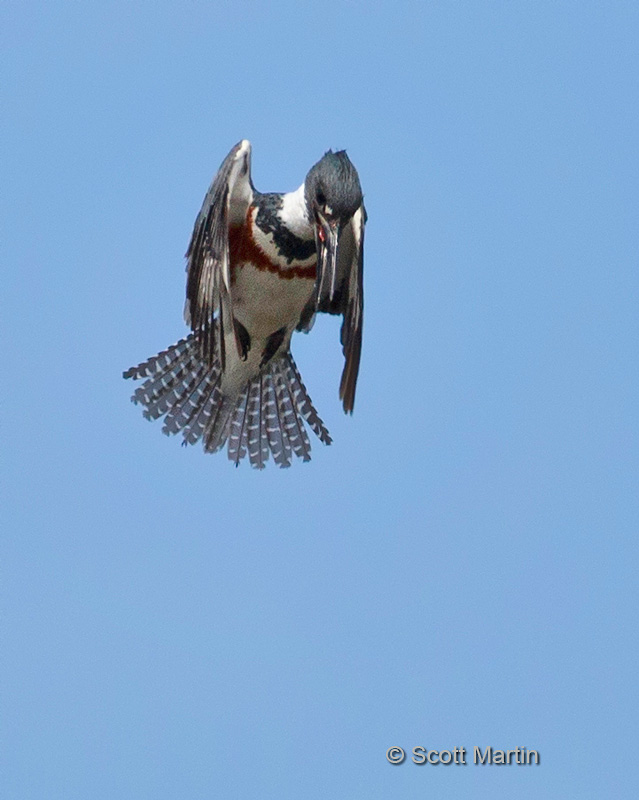
The female Belted Kingfisher is slightly larger than the male and is also one of the few species of bird where the female is more colourful than the male. The female is easily differentiated from the male by the rufus stripe across the chest below the slate blue belt that is found in both sexes.
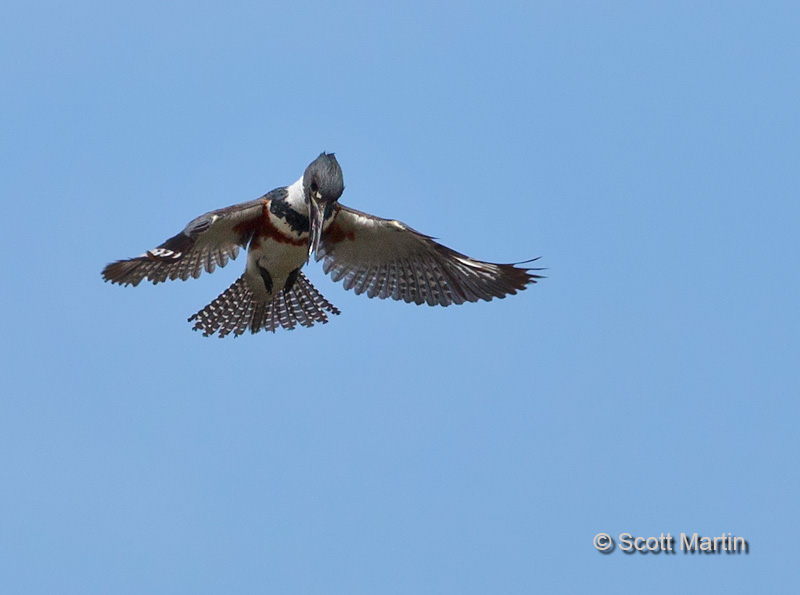
Once a fish is spotted the Kingfisher dives very quickly striking the water at a high rate of speed propelling it well below the surface.
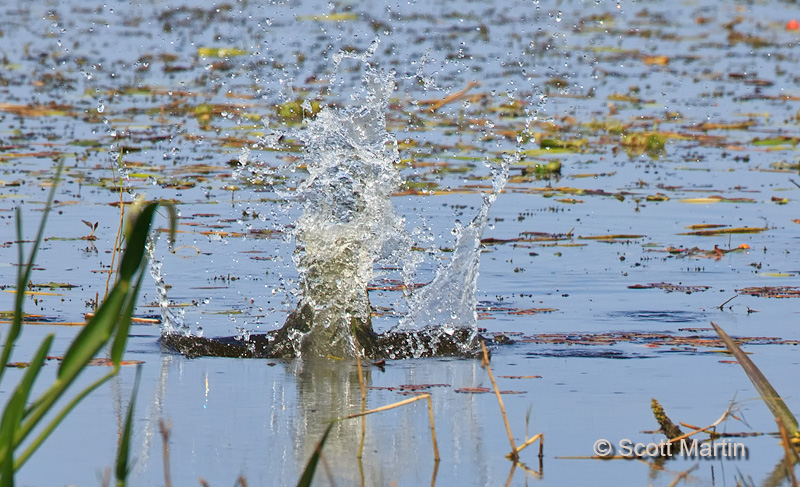
Note the clean lines of the entry zone, which will help make the next few slides make more sense as they record the Kingfisher launching itself out of the water at the end of its dive. Although I’ve seen Kingfishers dive many times before I had no idea how they launched themselves out of the water so the following images proved very educational. The next slide shows the appearance of the tail and wingtips as the Kingfisher prepares to use a strong wing beat to propel her body straight up out of the water. You can tell this is an exit shot by the waves around the impact zone and the seaweed in the air above the bird caused by the prior impact.

The energy expended to launch the bird vertically from the water must quickly exhaust the bird, so I doubt they can make many dives without a rest.
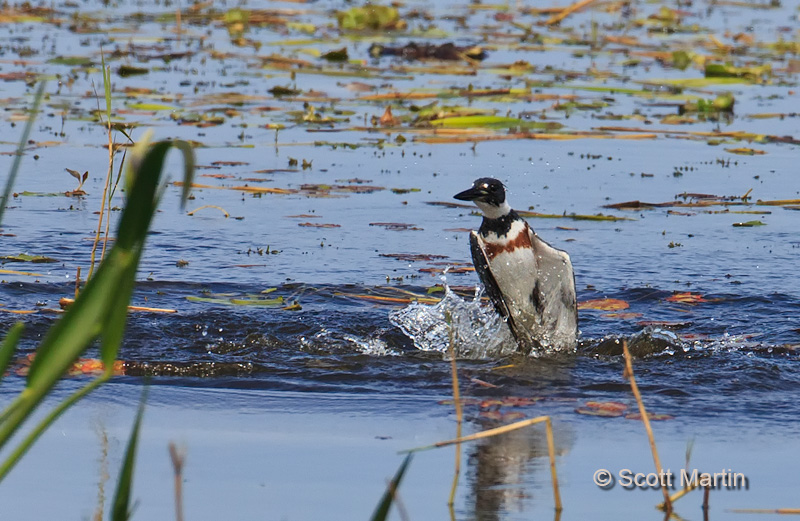
The vertical distance required must be high enough for the bird to take flight.
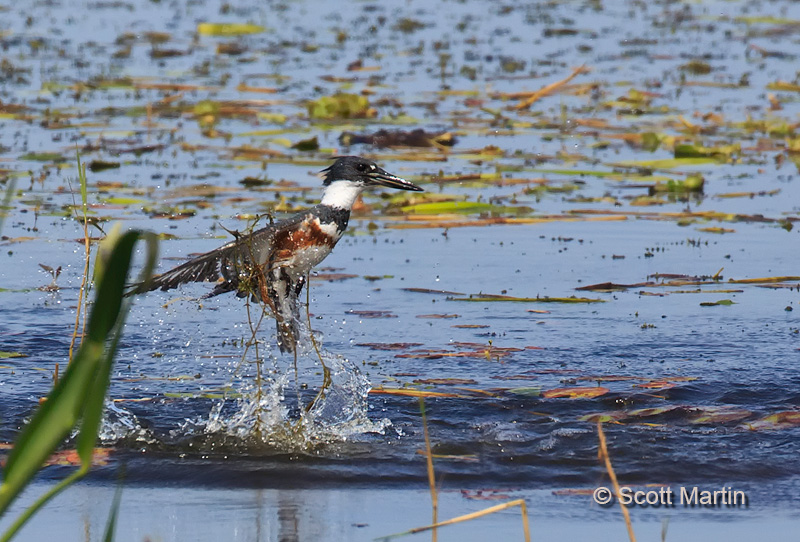
And off she goes, in this instance without any food.
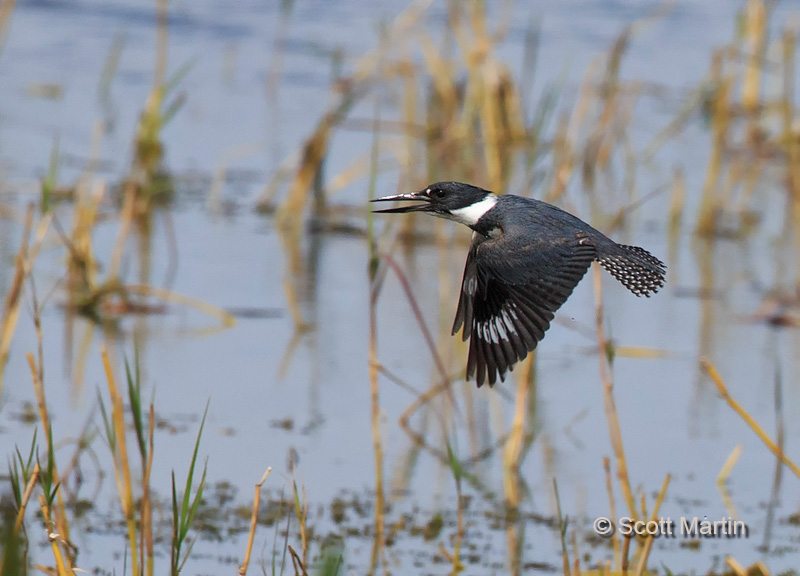
.
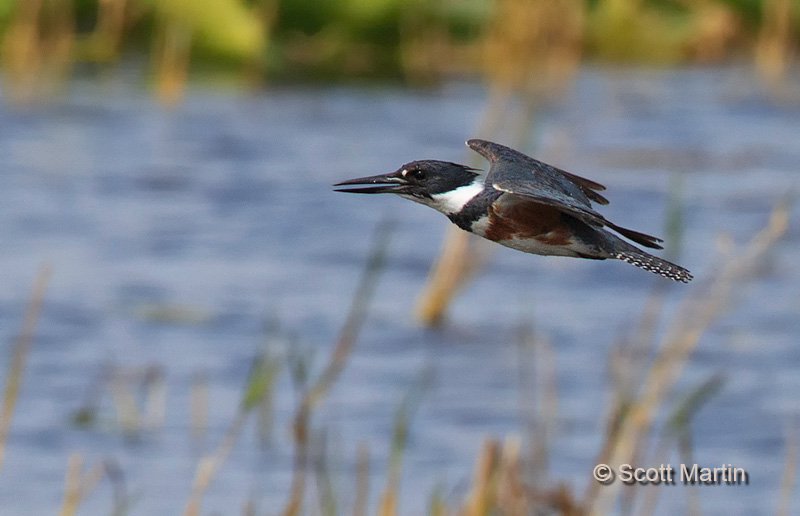
.
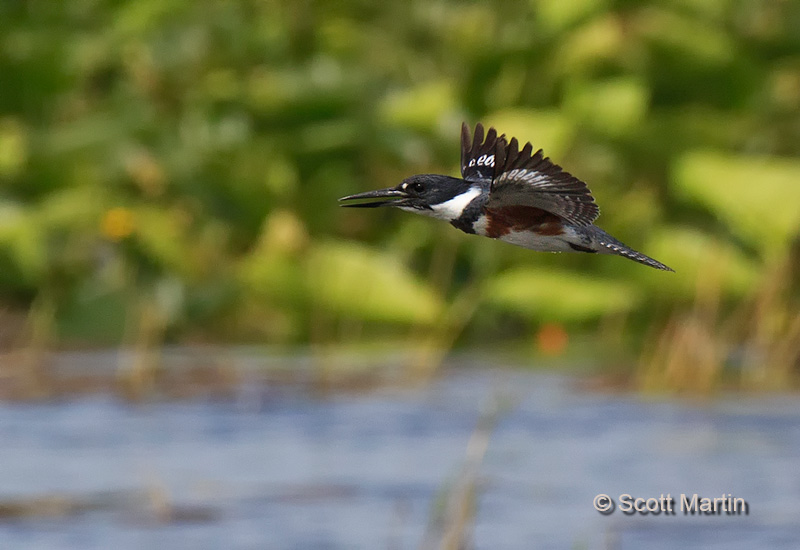
.

It was a blessing to be standing in the right place at the right time to record this Belted Kingfisher diving and as a result learn a little about how they ‘eject’ themselves from the water after a dive. It was also a pleasure to ‘kind of’ cross a longstanding bird off the nemesis list, not completely though, as I still need to get some print worthy images of this intriguing bird.
The above sequence was taken using a Canon 5D MkIII with a 500 mm f/4 lens, not a set-up typically used for birds in flight, however the 5D autofocus seemed to track the bird well.
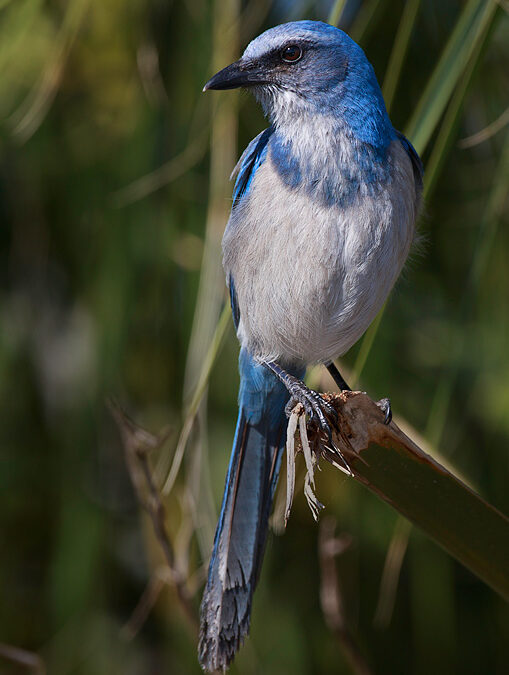
by Scott Martin Photography | Apr 13, 2013 | Birds, Blog, Educational, Song Birds
The Florida Scrub Jay is Florida’s only endemic bird and one of only fifteen bird species endemic to the United States. It is believed that there are approximately 8,000 Florida Scrub Jays alive and their numbers are decreasing at a rate of approximately 10% every ten years. As a result of their rarity and decreasing numbers they have been listed as Vulnerable, which means that unless conservation action to restore their dwindling habitat is taken they will become threatened.
As the Florida Scrub Jay is only found in Central Florida, the bird tends to be a celebrity among birders who travel long distances to see one. In fact, Deb & I met a couple from Sweden who had travelled to Florida last month just to see a Florida Scrub Jay. It was our pleasure to take them to an area where Scrub Jay’s were nesting and they were able to check another species off their life list. An interesting characteristic of the Scrub Jay is their inquisitive, social nature that renders them very tame. They readily land on your hand, shoulder or camera lens waiting to be fed a peanut. This comes as a complete surprise when you first encounter Scrub Jays as although they may be rare and difficult to find, when you do, they are instantly your best friends.
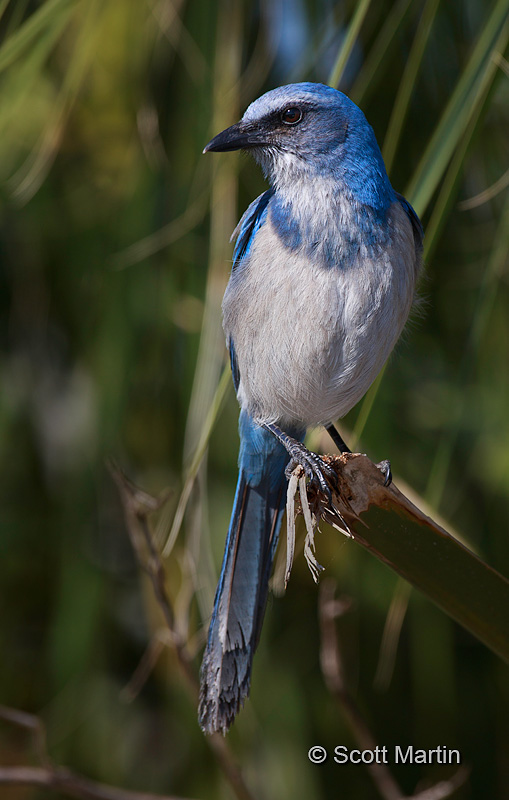
They do look similar to our Blue Jays and are about the same size as well.
Due to their friendliness and unique stature Florida Scrub Jays are among the most studied of all the birds. Consequently most seem to banded, much like we see with our Gray Jays in Algonquin Park. Scrub Jays normally have three or four bands, a silver metal band with an ID # from the US Fish & Wildlife Service, plus two or three coloured plastic bands which indicate when and where the bird was banded. The banding of birds allows researchers to monitor the movements of birds within their range as well as record other data. The next image shows a banded bird.
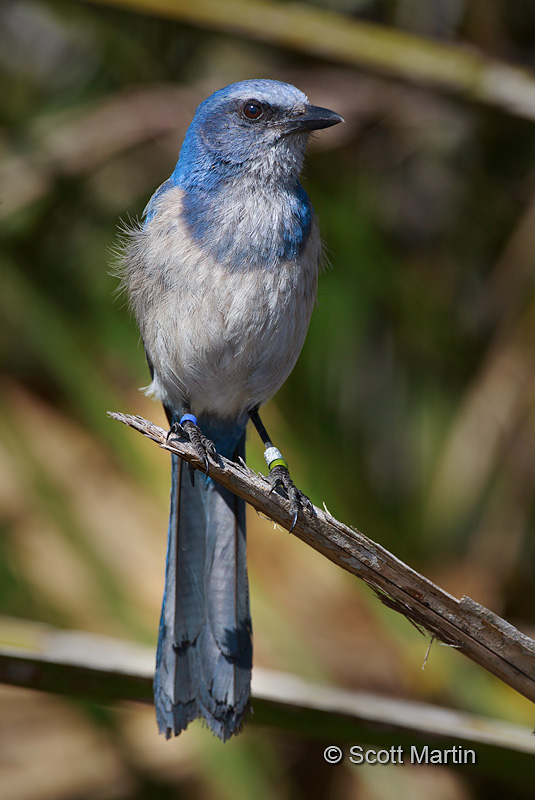
The next profile shot illustrates their lack of wing colour and detail as typical with our Blue Jays.
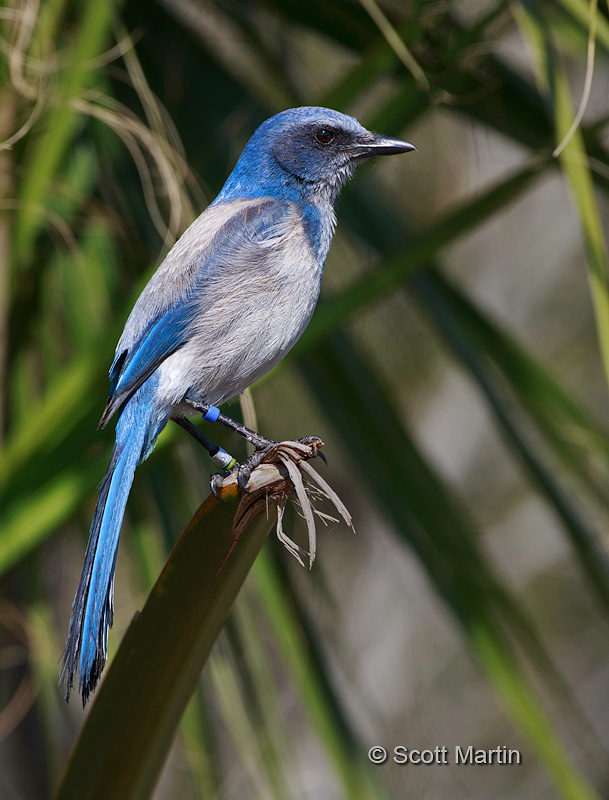
.
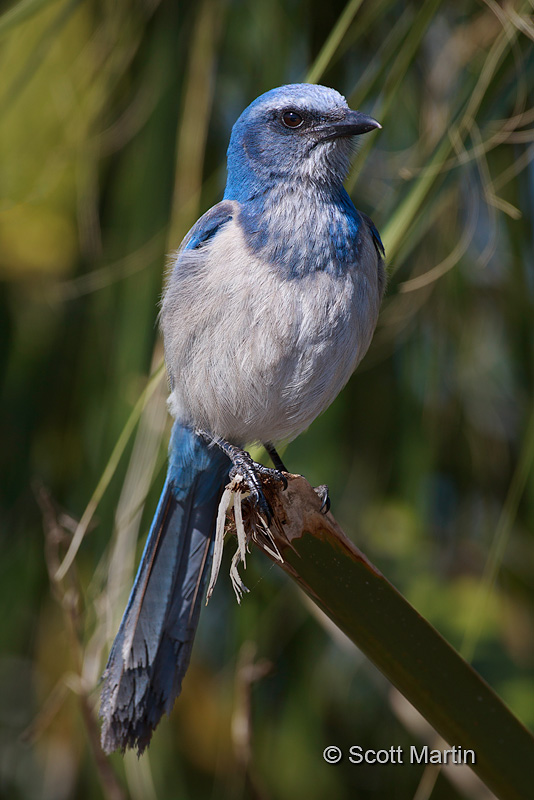
It was hard to get a good shot of the back of Scrub Jay, so please excuse the busy back ground in this next image.
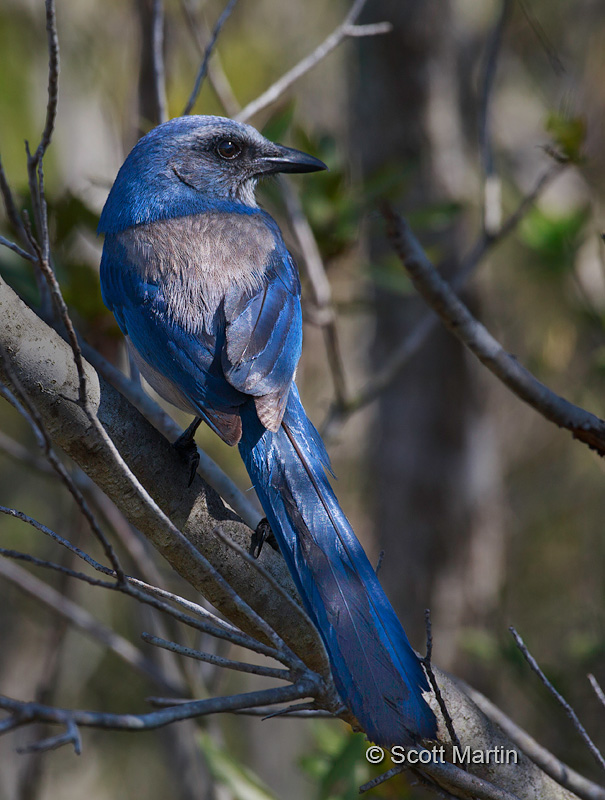
Other Scrub Jays can been viewed in the Jays Ravens & Crows Gallery
From a photographic perspective, getting bird images that are more than just snapshots requires controlling as much of what the final image will look like as possible. For me that involves thinking about the back ground as much as the object, which is not an easy thing to train yourself to do. When was the last time you looked through your viewfinder and thought as much about what was in the back ground as you did the object? If you are like me, you may not have thought about the back ground at all! A few suggestions to help improve your results next time out are; look for the least cluttered back ground as possible, look for uniform light density throughout (avoid bright spots, especially ones that encroach on the object), try to get as much distance between the object and back ground as possible which helps blur the back ground and isolate the object. Don’t forget to move around with your feet or zoom with your lens to help accomplish the above suggestions. In terms of thinking about the object, next to ensuring proper focus, exposure and light direction, for me the most important thing is to avoid shadows on the bird. This is not always possible due to the nature of bird photography however it is always the ideal. Have a another look at the second image in this post and see how distracting the shadow on the tail is…almost ranking up there with the bands! The last image is greatly hampered by the cluttered background (which is exacerbated by the lack of separation between the object and back ground) and that half of the tail is under a shadow, however as is often the case, it was the only frame that clearly showed the back of the bird, no matter how hard I tried to get that ‘keeper’ shot of the back.
So next time, try to think about the things that will help move your results from snapshots to photographs, but never think so much about the results that you don’t enjoy your time out with your camera!
All the above images were taken with a Canon 5D MkIII and 500mm lens using a Jobu monopod and Jobu Jr. 3 gimbal head.
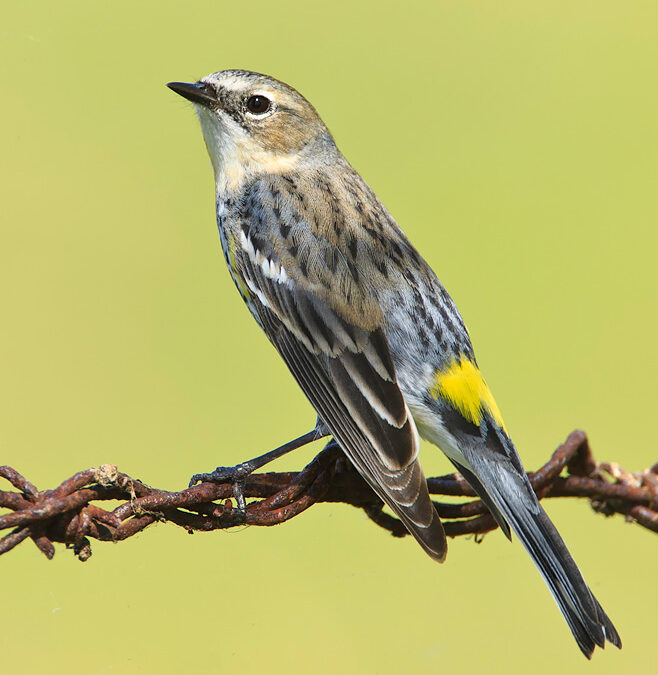
by Scott Martin Photography | Apr 11, 2013 | Birds, Blog, Shore Birds & Waterfowl, Warblers
Although we are expecting a snow storm tomorrow, the early migrants are returning to the area after wintering down south. It’s great to hear their songs every morning as I leave for the office. Probably my favourite birds to photograph in the spring are the many warblers that pass through the Oshawa area in May & June. Oshawa is a unique warbler location as there is a small woods next to the lake that contains the only remaining “Old World” White Pine stand on the North West shore of Lake Ontario and many of the warblers desire this unique habitat. One of the more common warbler species is the Yellow-rumped Warbler and we were fortunate to photograph one while in Florida last month.
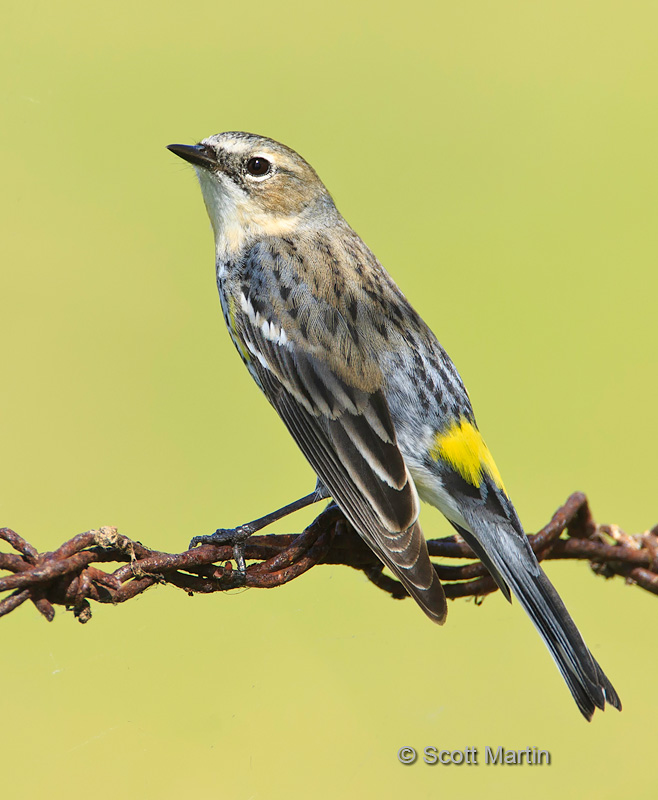
.
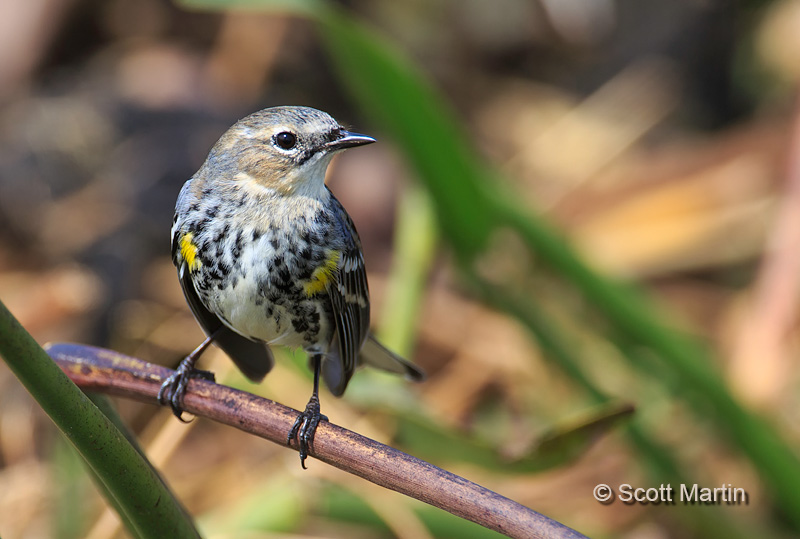
.
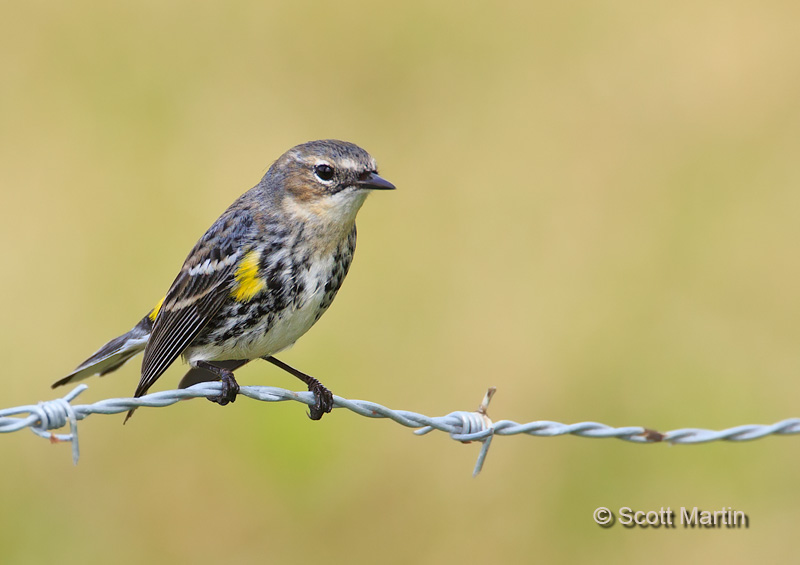
Normally we don’t post images on man-made perches, however a nice pose against a clean back ground makes the barbed wire seem not quite as bad!
This Yellow-rump was photographed at Lake Kissimmee in Florida at the end of Joe Overstreet Road. Other warbler images can be seen by following this link to the Warbler Gallery.
While in Florida visiting the Merritt Island Nature & Wildlife Preserve we were fortunate to photograph a number of Lesser Scaups. Lesser Scaup’s prefer fresh water (Greater Scaups like salt water) and are one of the most abundant diving ducks in north America although in recent years their numbers have been in sharp decline. Even though Scaups are common, this was the first time Deb and I had ever seen or photographed them.
Male in breeding plumage.
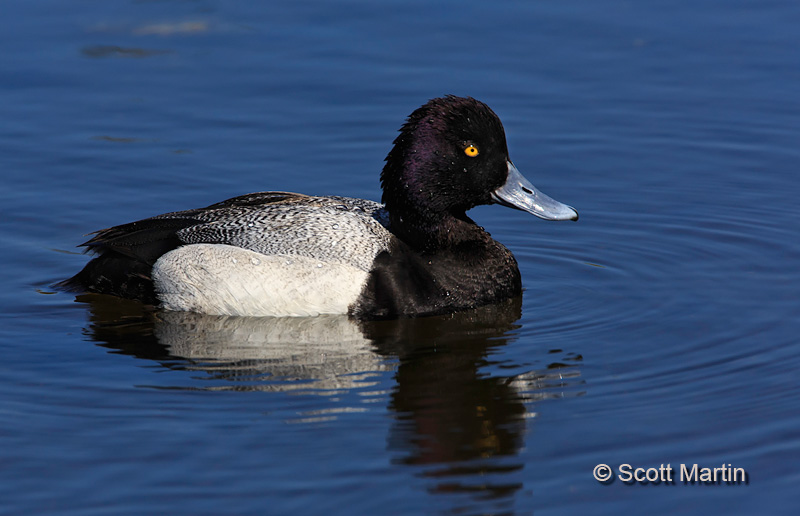
This next image is not as visually appealing as the previous image because the reflection of the head is cut of by the bottom of the frame, however it does clearly show the unique marking on the distal aspect of the bill, which is why it is included in this post. Any elements of visual importance in an image tend to detract from the image when they touch the edge of the frame so try to leave ample room around your subject when out taking pictures. You can always crop the image in post processing, however when you crop the image “in the camera” like I did in this next shot, you are stuck with less than ideal results.
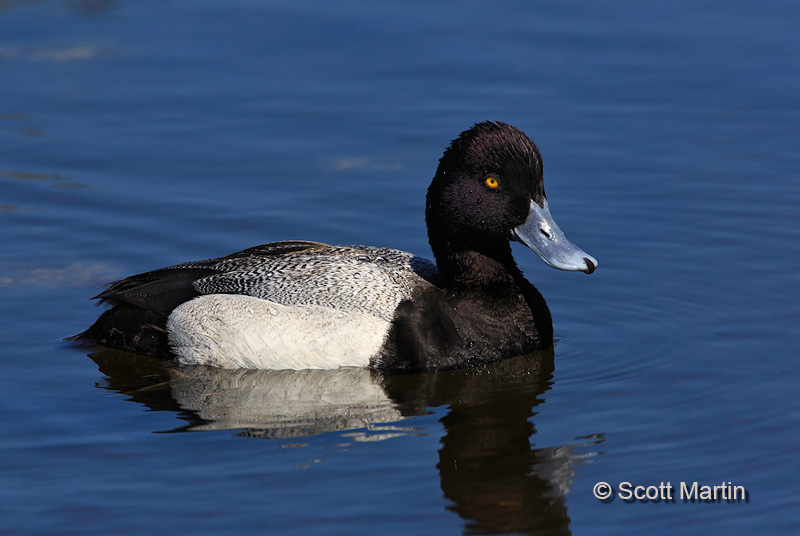
Non breeding male plumage or a young male.
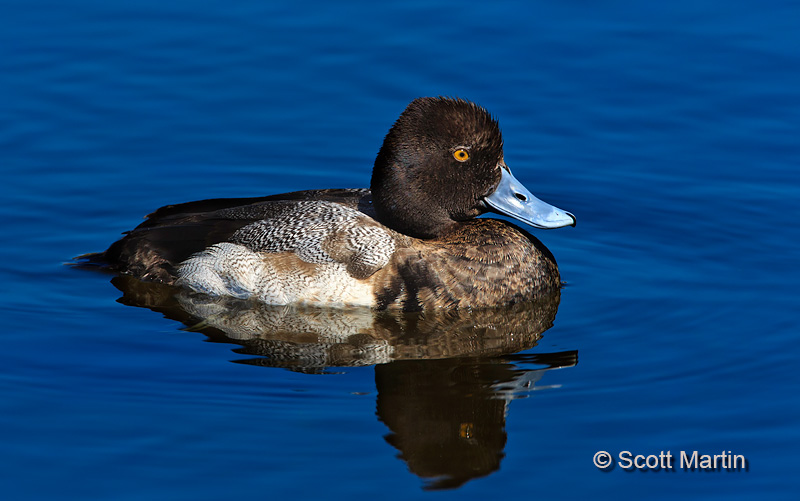
Female Lesser Scaup.
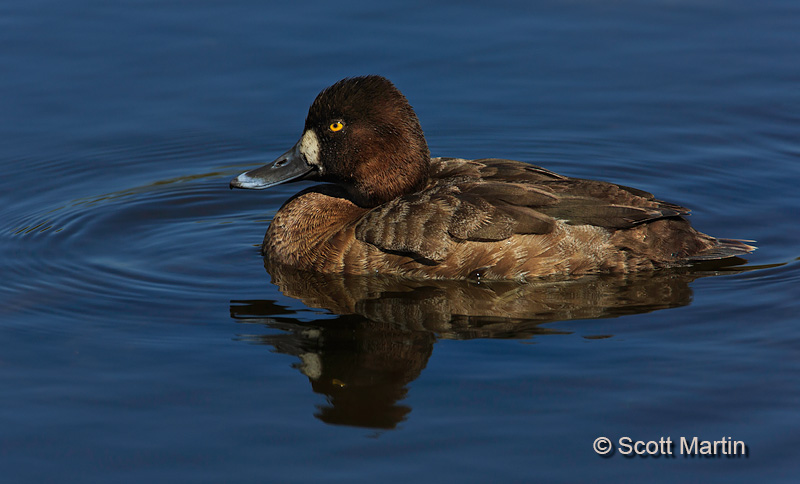
.
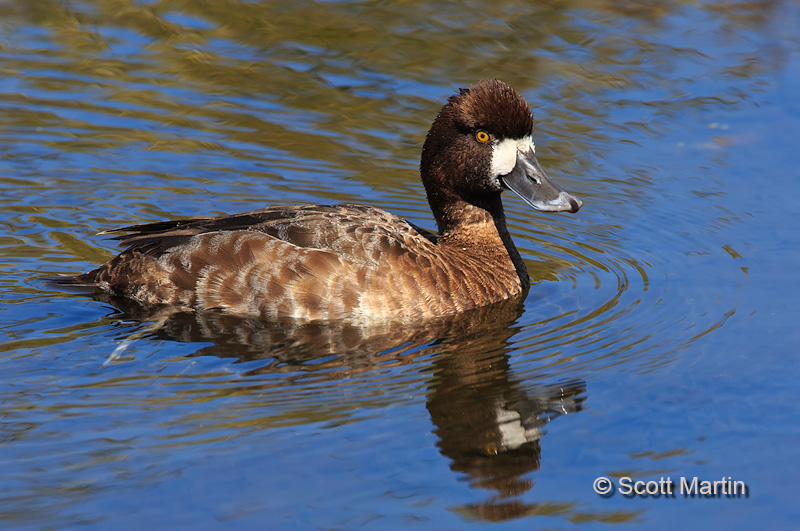
All images in this post were taken with a Canon 5D Mk III and EF 500mm L IS lens supported on a Jobu monopod and Jobu Jr. 3 gimbal head.



























Follow Scott Martin Photography